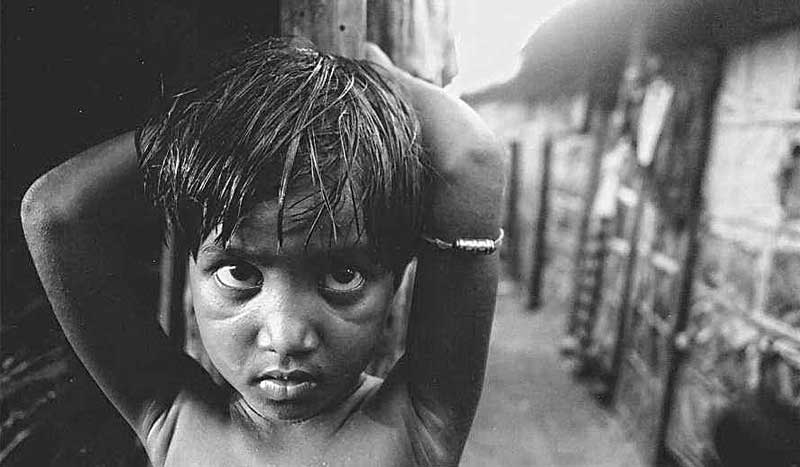Published in The Daily Star on Thursday 16 January 2020

Let us do an exercise. Clench your fist, and then gently loosen your fingers a little. Now hold up your loosely clenched fist up to your eye and try to peer through it to the other side. It is dark. There seems to be light on the other side, but it seems very distant. You see only parts of objects, and it makes it hard for you to discern what the entire thing may be. Since you are acclimatised to seeing the picturesque panorama of the world from childhood, even momentarily restricting your vision makes you feel confined and confused. Yet, those who are unfortunate enough to be born into poverty, live their entire lives inside the clenched fist of the world. Such an existence is characterised by persistent pressure from all forces—natural, social, economic and political. It is a deprivation that degrades humans into lesser beings. Those who are cursed with poverty from birth have committed no crime. They were only born to the wrong parents.
In his book, “Challenging the Injustice of Poverty”, eminent economist Professor Rehman Sobhan advocates that poverty is not merely income deprivation, but rather a multi-dimensional exclusion from opportunities for development and decision-making in society. Professor Sobhan argues that injustice lies at the crux of poverty, and it is an unjust social order which creates unequal opportunities that lead to unequal outcomes. Such injustice is structural in nature, since it stems from a social order which determines the operation of both market forces and institutions. He points out that structural injustice originates inequalities in terms of access to assets, participation in the market, access to human development and governance. To correct structural injustice, Professor Sobhan proposes several measures, such as expanding the ownership and control of the excluded people over productive assets and strengthening the capacity of the excluded people to compete in the market.
Bangladesh has made commendable progress on the first sustainable development goal (SDG), which calls upon countries to end poverty in all its forms everywhere. According to data from the Bangladesh Bureau of Statistics (BBS), the proportion of population living below the national upper poverty line in Bangladesh has fallen from 56.7 per cent in 1991-92 to 24.3 per cent in 2016. However, in order to reach the government’s milestone of having a maximum of 18.6 per cent of the population living below the national upper poverty line by 2020, the rate of poverty reduction needs to be increased.
The total number of underprivileged people in Bangladesh has been reduced from 83.06 million in 1992 to 39.60 million in 2016. Thus, roughly halving the incidence of poverty between 1991-92 and 2016 has resulted in around 43.46 million people coming out of poverty in a matter of only 24 years. Bangladesh’s accomplishments in reducing extreme poverty are even more impressive. The percentage of population living below the national lower poverty line decreased from 41 per cent in 1991-92 to 12.9 per cent in 2016. At this rate, it is likely that Bangladesh will reach the government’s milestone of having a maximum of 8.9 per cent of the population below the national lower poverty line by 2020. Nevertheless, the pace of poverty reduction has been slowing down. Between the period 2005 to 2010, poverty rates fell by 1.7 per cent annually on average, whereas between the period 2010 to 2016, poverty rates fell by 1.2 per cent. This means that as the last mile is approaching, Bangladesh may find it challenging to repeat its miraculous poverty reduction record of the past.
Concurrent with poverty alleviation, Bangladesh has also managed to expand the coverage of its social safety net programmes. The proportion of households receiving social safety net benefits increased from 13.06 per cent in 2005 to 27.80 per cent in 2016. This is clearly a step in the right direction, in terms of making sure that “No One is Left Behind”. Nevertheless, there is still much that needs to be done. For example, the social safety net allocation has been hovering at around 14 per cent of the total national budget during fiscal year 2008-09 to 2018-19. Additionally, the bulk of funds allocated for social safety nets is earmarked to provide pension for government officials. Therefore, in order to ensure that the “farthest behind are reached first” it is important to decouple pension of government officials from the social safety net budget allocation, and gradually shift from the humanitarian approach of safety nets to the rights-based approach of social protection.
Nonetheless, ultimately it must be kept in mind that there is no elixir that can magically end poverty. As long as the unjust economic, political and social structures that produce and perpetuate poverty are not decisively dismantled, the deprivation of the poor shall persist. The first step towards rejecting the socio-economic order that prevents elimination of poverty is to understand the sufferings of the poor. But for most of us, this will be no easy task. Since privilege usually goes unnoticed to those who are privileged, it is unlikely that we will be able to empathise with the plight of the poor. This is why we need to view the world through a loosely clenched fist, because it is only through the act of closing down our field of view, that our eyes will really be opened to poverty and the limited lives of the poor.
Syed Yusuf Saadat is Senior Research Associate, Centre for Policy Dialogue



